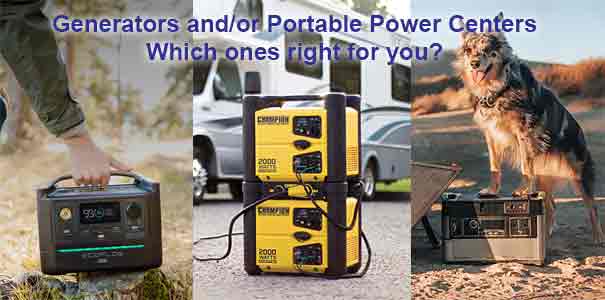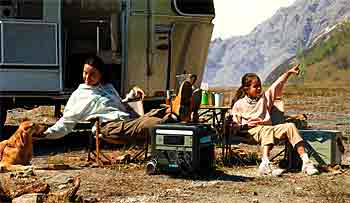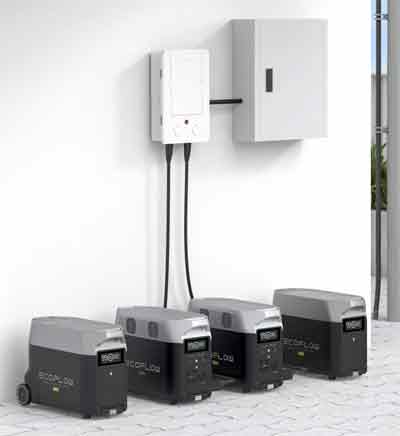Generators or Portable Power Centers: Which One is Right for You?
One thing we all have in common is the need for access to electrical power. With on-grid living, getting electrical power is as easy as plugging the cord into a wall outlet. But tiny living usually demands a greater level of understanding when it comes to what we need and how to get it.
There are several ways to access electrical power, as we’ve discussed in other pages (RV Shore Power, Surge Protectors, 50/30 Amp Hookups and Running RV Appliances Off-Grid) We’re devoting this page to understanding generators.
Understanding how generators work can keep you from frying your electronics and/or tripping your circuit breakers, as well as guiding you to purchase the proper equipment for your needs.
First, let’s look at types of generators
- Inverter generators (excellent for camping, low-wattage uses, and electronics)
- Open-frame portable generators (powerhouses of various sizes with some limitations)
- Standby or stationary generators (kick on when power fails and turn off when power is restored)
- Portable Power Centers (not generators- just big batteries that can be charged by plugging them in to a 110 outlet, by solar power, or by real generators)
- Solar generators (not really generators, but solar panels will charge your batteries)
Of course, all inverter, open-frame, and standby or stationary generators must be run outdoors.
Second, let’s look at what you’ll be using it for
- Construction site, needing electricity for power tools but no electronics
- Small RV or travel trailer, needing only power for electronics and small appliances
- Large RV, large travel trailer, or tiny house, needing power for electronics, small appliances, and large power-sucking appliances like air conditioners and washer/dryers
- Stick house, mobile home, modular home, park model, or grid-tied tiny house
Third, understand the power being delivered
Inverter generators produce pure or clean sine-wave alternating current (necessary to avoid damage to sensitive electronics).
Regular open-frame generators produce “dirty” alternating current. Inverter generators are costly and generally only produce enough power for your electronics and small appliances. Open-frame generators come in varying degrees of power; to mitigate the potential damage to your electronics, you would simply need to use a power conditioner (looks like a surge protector) plugged into an outlet for your computers, televisions, phones, tablets, etc.
Lastly, determine how much wattage you will need
Will you want to run everything in your house with little interruption? You’d need 10,000 watts. Can you get by with just your refrigerator and furnace? Or will you be running a circular saw and an air compressor at a job site?
Use the chart on the Running RV Appliances Off-Grid page to get an idea of how much wattage you will need when your generator is powering your devices.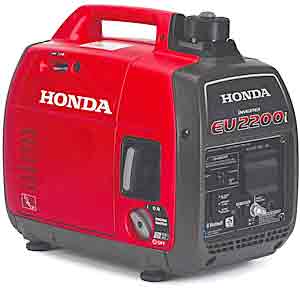
1. Inverter Generators
Camping, Electronics
We have a separate page on Inverter generators which are great for camping and lower wattage uses. They have the inverter built in so they output clean 110 volt, 60 Hz. AC power which can be safely used for sensitive electronics. Inverter/Generators are also then quietest because they will usually be running nearby. These are great for RVs, travel trailers, and camping situations.
2. Open Frame Portable Generators
Depending upon the size, suitable for homesteading, off-grid living, full-time RVing, tiny houses, workshops, job sites
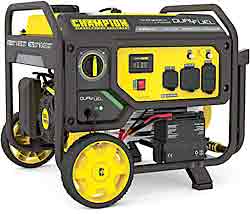 Open-frame portable generators are sometime less expensive because they’re not permanently installed in a noise-abatement housing and don’t have the auto on/off or self-test features. Because my area’s power grid is very stable, I have a portable generator sitting in the garage. If needed, I’ll wheel it outside and run a heavy-duty extension cord into the house. I could have a port installed in my home’s electrical system for easier distribution.
Open-frame portable generators are sometime less expensive because they’re not permanently installed in a noise-abatement housing and don’t have the auto on/off or self-test features. Because my area’s power grid is very stable, I have a portable generator sitting in the garage. If needed, I’ll wheel it outside and run a heavy-duty extension cord into the house. I could have a port installed in my home’s electrical system for easier distribution.
Because this generator does not have an inverter, the power is not suitable for sensitive electronics. The cost is substantially less. A similar Champion Inverter/Generator is approximately $1K*. Of course, the electronics issue can be remedied by adding a power conditioner.
The Champion 4750/3800-Watt Gas and Propane Dual Fuel Powered Portable Generator with electric start shown here is just $599.00 from Amazon.* They say it runs at a surprisingly quiet 68 db, but owners report it to be more like 76 db. See my page on How to Quiet Down Your Generator.
Because it only weights 119 lbs. and has wheels, you’ll need to come up with a security device so it doesn’t “grow legs and walk away.” I chain mine to the bumper of my RV. Do not run these in your garage.
Generators in an off-grid situation
Generators in off-grid homes are frequently used in conjunction with a solar system to charge a battery bank. The generator is frequently kept in a separate structure near the solar system equipment. The homeowner keeps a close eye on their energy usage and battery level. If the solar panel is not keeping the batteries sufficiently charged, the generator might be needed. A remote controlled on/off feature is nice for this.
Charging your battery bank with a generator
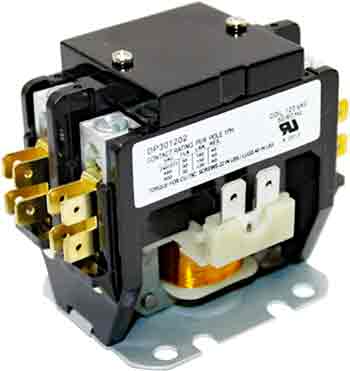 Portable generators should not be used to power sensitive electronics because they do not have inverters to create a stable 110 volt, 60 Hz. sine wave. But they are fine for charging batteries. The solar system has an inverter down the line. Frequently a transfer switch like the one seen below is used to automatically switch the generator on. The wiring gets a little tricky because you use the PV (photo-voltaic) panels as the line voltage, but the generator will want to back-feed through the switch that we don’t want. An isolation contactor switch needs to be installed. Feed the coil on the PV contactor from the “utility” side in the Transfer Switch.
Portable generators should not be used to power sensitive electronics because they do not have inverters to create a stable 110 volt, 60 Hz. sine wave. But they are fine for charging batteries. The solar system has an inverter down the line. Frequently a transfer switch like the one seen below is used to automatically switch the generator on. The wiring gets a little tricky because you use the PV (photo-voltaic) panels as the line voltage, but the generator will want to back-feed through the switch that we don’t want. An isolation contactor switch needs to be installed. Feed the coil on the PV contactor from the “utility” side in the Transfer Switch.
From a NABCEP certified electrician in Austin: “When the transfer switch is feeding the panel from the utility source, it is also keeping the PV contactor closed and operable. When the transfer switch switches and is feeding the generator, the contactor opens because it is no longer held closed by the utility power. PV can’t start-up until utility power is restored.”
This Inverter/Charger has a generator input
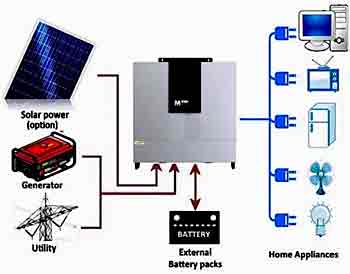 RICH Solar Hybrid 6048 6000W 48V All-in-One Solar Inverter / Charger | Split Phase 120V/240V – MPPT Input + Grid Utility Charger
RICH Solar Hybrid 6048 6000W 48V All-in-One Solar Inverter / Charger | Split Phase 120V/240V – MPPT Input + Grid Utility Charger
An easier way to tie your generator to your solar system is to use the All-In-One Rich Solar Hybrid.
The RS-H6048 is simplifying off-grid solar power. This is a complete solar system in a box. These units have been a staple in the off-grid solar power community for years, for good reason. All you need to do is mount the box to the wall, connect your panels and your batteries, and you’re in business. You have a fully functioning off-grid solar kit.
The 6048 is a perfect beginner-friendly option for someone who wants to install a big off-grid solar system, but doesn’t have a ton of experience. With everything built-in to both 6048 units – you can literally be up and running off-grid within hours.
These are available from Shop Solar Kits for $1,199.00* with financing available. Click on image to see details.
Paul & Sandra from Homesteading Ways and Beyond
Paul gives us a tour of his generator shed in this YouTube® video. Most off-grid folks have a generator shed separate from the house to minimize the noise. This is also a good place to house the solar panel system.
Notice Paul has three generators. A Sportsman*4500 watt duel-fuel open-frame generator to operate the larger appliances in the cabin, a very small one, 1000 watt, to charge the battery bank if the solar cells aren’t getting enough sun, and a bigger generator to run the power tools and equipment down in the barn.
Note about Sportsman generators:
*With any generator bought online, check the warranty. On the Sportsman Generator website they state, “Sportsman / Buffalo Corporation warranty applies to the original owner only, and only if purchased from an authorized Buffalo Corp retailer. Factory seconds, discounted or second-hand products, or products purchased from third party retailers found on Amazon or eBay are not covered by our warranty.”

Shop Solar Kits will hook you up with the best equipment for you, drawing from all major brands like EcoFlow, Bluetti, Renogy, Jackery, and more. Solar kits yes, but so much more. Check ’em out.
My Favorite Portable Generators
Here are a few of my favorite portable generators that you should consider purchasing for your needs.
Westinghouse WGen7500 Portable Generator with Remote Electric Start
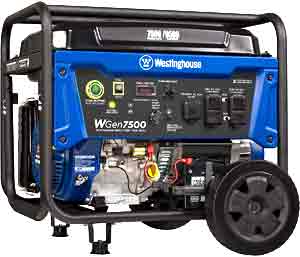
The Westinghouse WGen7500 features a one-touch push-button electric start with an included remote start key fob to conveniently fire it up from a distance. 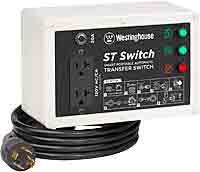
This generator is transfer switch ready, has an intuitive control panel, and features water resistant GFCI outlets. Combined with four 120V standard household outlets, this makes the WGen7500 a perfect choice for DIY projects, emergency home backup use, or even to power your travel trailer. The transfer switch makes is quite usable as a standby generator.
It outputs 7,500 watts with peak wattage of 9,500. Powered by a 420cc Westinghouse 4-stroke OHV engine featuring a long-lasting cast iron sleeve with automatic low oil shutdown and digital hour meter.
Noise Level-72 dBA. Size: 27.2 x 26.1 x 26 inches. Weight: 192 lbs. Run time is 16 hours at 25% load.
$899.00* from Amazon. * There is a Duel Fuel Version for $938.34 * and version that adds a carbon monoxide shut-off sensor for $949.00*
Backed by 3-year Limited Service, Labor, and Parts Coverage with Nationwide Customer Service Network.
Here’s a real powerhouse:
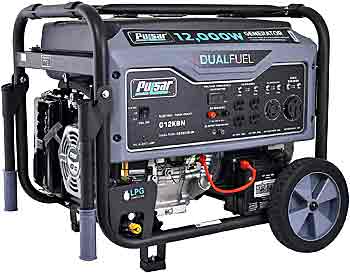
Pulsar G12KBN-SG Heavy Duty Portable Dual Fuel Generator – 9500 Rated Watts & 12000 Peak Watts – Gas & LPG – Electric Start – Transfer Switch & RV Ready. The powerful 457cc, Single Cylinder, 4-Stroke, OHV, Air-Cooled Engine runs 12 hours on 8 gallons of gas. 12,000 watts is enough to run everything in a 50-amp wired RV.
Duel Fuel feature provides you with many benefits as liquid propane can be stored longer and is a cleaner, more sustainable fuel source. It’s 28.5 x 26 x 25.5 inches with fold-down handles. 209 lbs. It operates at 74 db. 3-year Warranty.
Available from Amazon for $899.00.* Snag a really good deal on this beast from EBay as well.
3. Standby or Stationary Generators
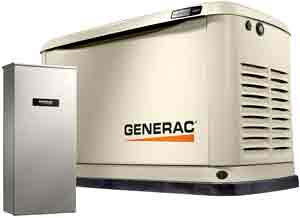
Standby generators are great for grid-tied houses. They kick on automatically when the grid power fails and turn off when power is restored. Some will self-test once a week. You can continue with your normal daily life with only a few seconds of interruption. These need to be wired into the house by an electrician.
These standby generators are large enough to easily run your whole house.
The Generac standby generator shown here delivers 10,000 watts. It includes the transfer switch and has a five year warranty. It can be controlled by an app. Cost is $3,797.00*. They claim less than 5% total harmonic distortion which makes them safe to be used with electronics.
4. Portable Power Centers
Portable Power Centers are not generators. They do not make electricity. They store electricity. These portable power centers are good-sized batteries with an inverter built in. There are several ways to charge the battery. They have really versatile output connectors to run or charge many of your gadgets at one time.
It’s actually a really good idea with several uses. These have been developed to the point of being useful for whole-home backup systems.
ANKER Portable Power Station
I use this ANKER Portable Power Station, Solix F2000.
The power is clean enough to safely run my computer and powerful enough to run the microwave oven and air conditioner in my RV. There’s a 30 amp RV plug in right on the front.
You can run several high powered devices at one time, up to 3600 watts, without overloading.
When I’m not camping the ANKER Solix F2000 stays next to the refrigerator. In case of a power failure it will run my refrigerator for 4.5 days.
It will fully recharge in under two hours when I plug it in. I haven’t sprung for the solar panels yet but it can recharge that way too. It will last over 3000 charges. That’s like charging it every day for over eight years.
It supplies 2048 wh. with an output of 2400 watts. Other manufacturers are scrambling to keep up with this beast. If you need more power you can double it with an expansion battery.
The app on my phone lets me keep an eye on the power usage and I can turn it off and on remotely.
It retails for $1,999.00* but is often on sale. You can get one right now for just $999.00* using this coupon code: WSTDSUMS54
EcoFlow Portable Power Centers
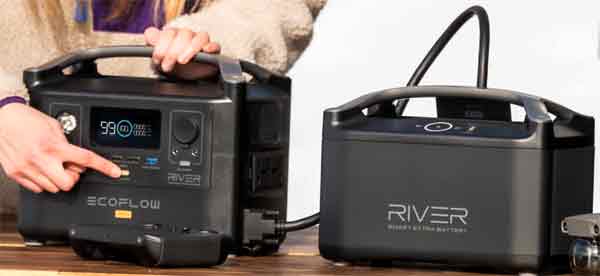
![]() EcoFlow has also developed a nice line of rechargeable power centers. The EcoFlow River will recharge from 0% to 80% in about an hour with the X-Stream accessory. Harness the power of the sun by linking up to two 110W solar panels. You’ll be fully charged in under 3 hours. Charge to full in just 6.5 hours by plugging right into your car with the car adapter.
EcoFlow has also developed a nice line of rechargeable power centers. The EcoFlow River will recharge from 0% to 80% in about an hour with the X-Stream accessory. Harness the power of the sun by linking up to two 110W solar panels. You’ll be fully charged in under 3 hours. Charge to full in just 6.5 hours by plugging right into your car with the car adapter.
The EcoFlow RIVER Max has 3 AC outlets and a capacity of 576Wh. The additional battery pack shown doubles the capacity. RIVER Max can power devices up to 1800W with their proprietary technology, X-Boost. It also has four USB outlets and two 12-volt outlets. The River Pro Extra Battery doubles the capacity of the entire system.
These lightweight devices are extremely well priced and warrantied for 2-years.
Use this coupon code at checkout for a 5% discount: ECOFLOWAFF
The EcoFlow Delta Pro
The EcoFlow DELTA Pro is the next leap in portable power technology. From tailgate power to extreme blackouts that last for days on end, DELTA Pro delivers up to 25kWh of capacity.
A single DELTA Pro unit packs a 3600W AC output, which can be expanded up to 4500W with X-Boost technology. Power 99.99% heavy-duty devices at home, outdoors, or at work. You can even pair two units together to achieve 7200W.
The EcoFlow DELTA Pro ecosystem stores energy day and night, reducing your reliance on the grid and lowering your energy bills by combating time-of-use rates. It integrates directly with your home using the EcoFlow Smart Home Panel. The EcoFlow app gives you a smart breakdown of your energy habits, and you can customize your energy usage for any type of situation.
Here’s a $200.00 OFF coupon code for the EcoFlow, Delta Pro. FRBE46NNNX8B Enter at checkout.
EcoFlow’s X-Stream charging technology isn’t just fast, it’s safe too. The battery management system ensures safety and longevity while you fully charge DELTA Pro from a standard AC wall outlet in 1.8 hours.
For the first time ever with a portable power station, you can charge up at thousands of EV stations worldwide. This unique charging method gives you up to 3000W fast charging on the go.
The EcoFlow Smart Generator
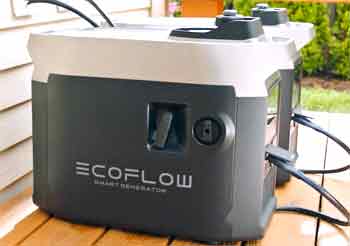 During extreme situations where you are running out of power and can’t generate enough through solar energy, the EcoFlow Smart Generator serves as a last-stand backup option. EcoFlow’s Smart Generator has the ability to auto-start when your DELTA Pro hits a low level of charge, re-charge your DELTA Pro, then it can stop the engine all by itself once your DELTA Pro hits a full charge. This enables maximum use of your battery, and minimum use of a generator.
During extreme situations where you are running out of power and can’t generate enough through solar energy, the EcoFlow Smart Generator serves as a last-stand backup option. EcoFlow’s Smart Generator has the ability to auto-start when your DELTA Pro hits a low level of charge, re-charge your DELTA Pro, then it can stop the engine all by itself once your DELTA Pro hits a full charge. This enables maximum use of your battery, and minimum use of a generator.
The EcoFlow Smart Generator has app control functionality. During emergencies, you can start, stop, and monitor your generator all from your phone and from the comfort of your house.
When compared to using a gas generator alone (which you might have traditionally done during blackouts) this solution is a smarter, superior, and cleaner alternative that keeps you powered on in almost any situation.
Bluetti is another solid manufacturer of portable power centers
The AC200L allows up to 900W of solar input and 400W via the adapter, you can even charge it up via your wall outlet and solar panels simultaneously, boost a stunning 1400W total charging rate which can top up your power beast in less than two hours!

Every Bluetti battery module has their own input port for AC adapters, and you’ll get another 400W of input capability with every module added (Up to two for the AC200L).
With AC200Ls 16 outlets, you get to run all your needs simultaneously without breaking a sweat. Especially for the RV enthusiasts, the AC200 L has a specially designed built-in 30A NEMA TT-30 outlet and a 12V 30A super powerful DC outlet.
These Bluetti generators use the LiFePO4 Battery with 3,500+ Life Cycles to 80%, and can charge in as little a 40 minutes.
5. There Really Is No Such Thing as a Solar Generator
An additional way to meet your electrical needs is solar power. A solar system consists of the solar panels, a large bank of batteries, an inverter, and various other components. For more information on solar equipment, visit this page.
The term “Solar Generator” was coined by the manufacturers of the portable power centers shown above. It make you feel more eco-friendly. Indeed, a portable power center can be charge by solar cells. Many portable power centers come packaged with a small bank of Portable solar panels.
Here are a few more pages on my website about generators you’ll be interested in:
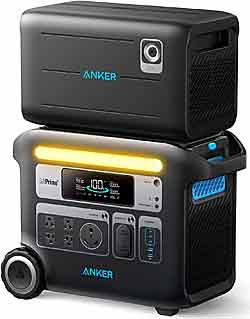
Anker Portable Power Station Solix F2000. with expansion battery for 4096 Wh. $2,799.00 Use this coupon code to get $1,200.00 off: WSTDSUMS58
Portable Inverter/Generators Comparison
Portable Power Centers How To Choose
How to Quiet Down Your Generator


